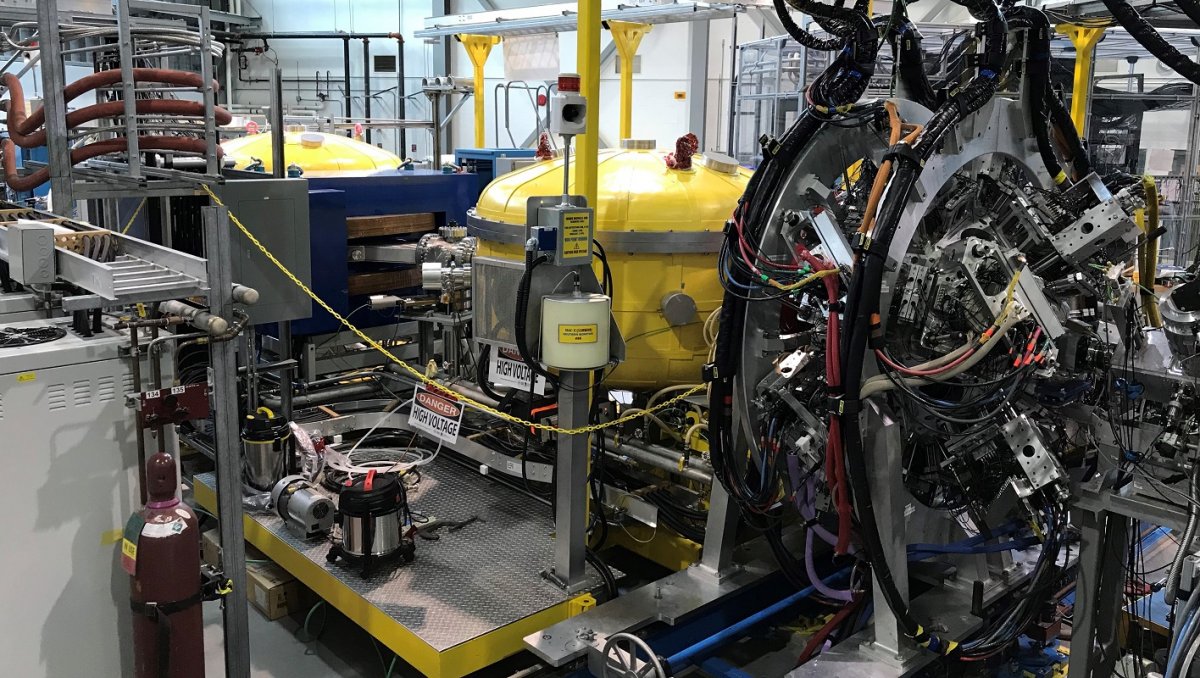From The University of Surrey (UK)
20 October 2021
Researchers in Surrey’s Nuclear Physics Group have collaborated with TRIUMF National Laboratory (CA) to achieve the first direct measurement of a supernova reaction in a laboratory using an accelerated beam of radioactive nuclei.

The experiment was conducted using the EMMA recoil spectrometer coupled with the TIGRESS gamma-ray array at TRIUMF National Laboratory.
The pioneering study, which found that the rate of astrophysical reaction being studied was significantly lower than previously predicted by theory, has been published in Physical Review Letters.
Determining the origins of elements heavier than iron in our galaxy remains one of the most burning open questions in modern science. This particularly applies to the 30 or so ‘p-nuclei’ which account for around one per cent of heavy elements observed in our solar system but whose astrophysical origins remain a mystery. Since it’s not possible to directly observe these elements in stars or supernova remnants due to their scarcity, the only way they could previously be studied was through a combination of experiments, theoretical models and meteoritic data.
The recent research, led by Dr Gavin Lotay of the Department of Physics. utilised advanced facilities at the TRIUMF laboratory, and the results indicate an increase in production of a specific p-nucleus, Strontium-84, during the gamma process (the most successful model for p-nuclei production to date). This may help to explain the observation of enhanced Strontium-84 levels in the Allende meteorite and throw light on other astrophysical processes.
Dr Lotay said: “The coupling of a high-resolution gamma-ray array with an advanced electrostatic separator to measure gamma process reactions represents a key milestone in the direct measurement of astrophysical processes. Such measurements were largely thought to be out of reach of current experimental technologies and the latest study has now opened up a wealth of possibilities for the future.”
See the full article here .
five-ways-keep-your-child-safe-school-shootings
Please help promote STEM in your local schools.
About the The University of Surrey (UK)
The University of Surrey is a public research university in Guildford, Surrey, England. The university received its royal charter in 1966, along with a number of other institutions following recommendations in the Robbins Report. The institution was previously known as Battersea College of Technology and was located in Battersea Park, London. Its roots however, go back to Battersea Polytechnic Institute, founded in 1891 to provide further and higher education in London, including its poorer inhabitants. The university’s research output and global partnerships have led to it being regarded as one of the UK’s leading research universities.
The university is a member of the Association of MBAs and is one of four universities in the University Global Partnership Network. It is also part of the SETsquared partnership (UK) along with The University of Bath (UK), The University of Bristol (UK), the University of Southampton (UK) and The University of Exeter (UK). The university’s main campus is on Stag Hill, close to the centre of Guildford and adjacent to Guildford Cathedral. Surrey Sports Park is situated at the nearby Manor Park, the university’s secondary campus. Among British universities, the University of Surrey had the 14th highest average UCAS Tariff for new entrants in 2015.
A major centre for satellite and mobile communications research, the university is in partnership with King’s College London (UK) and the Dresden University of Technology [Technische Universität Dresden] (DE) to develop 5G technology worldwide. It also holds a number of formal links with institutions worldwide, including the Surrey International Institute (UK), launched in partnership with the Dongbei University of Finance and Economics [东北财经大学](DUFE) (CN). The university owns the Surrey Research Park, providing facilities for over 110 companies engaged in research. Surrey has been awarded three Queen’s Anniversary Prizes for its research, with the 2014 Research Excellence Framework ranking 78% of the university’s research outputs as “world leading” or “internationally excellent”. It was named as The Sunday Times University of the Year in 2016.
Current and emeritus academics at the university include ten Fellows of the Royal Society, twenty-one Fellows of the Royal Academy of Engineering, one Fellow of the British Academy and six Fellows of the Academy of Social Sciences. Surrey has educated many notable alumni, including Olympic gold medallists, several senior politicians, as well as a number of notable persons in various fields including the arts, sports and academia. Graduates typically abbreviate the University of Surrey to Sur when using post-nominal letters after their degree.
Research
The university conducts extensive research on small satellites, with its Surrey Space Centre and spin-off commercial company, Surrey Satellite Technology Ltd. In the 2001 Research Assessment Exercise, the University of Surrey received a 5* rating in the categories of “Sociology”, “Other Studies and Professions Allied to Medicine”, and “Electrical and Electronic Engineering” and a 5* rating in the categories of “Psychology”, “Physics”, “Applied Mathematics”, “Statistics and Operational Research”, “European Studies” and “Russian, Slavonic and East European Languages”.
The 5G Innovation Centre (5GIC) at the University of Surrey opened in September 2015, for the purpose of research for the development of the first worldwide 5G network. It has gained over £40m support from international telecommunications companies including Aeroflex, MYCOM OSI, BBC, BT Group, EE (telecommunications company), Fujitsu Laboratories of Europe, Huawei, Ofcom, Rohde & Schwarz, Samsung, Telefonica and Vodafone – and a further £11.6m from the Higher Education Funding Council for England (HEFCE).
In addition, the Surrey Research Park is a 28 ha (69-acre) low density development which is owned and developed by the university, providing large landscaped areas with water features and facilities for over 110 companies engaged in a broad spectrum of research, development and design activities. The university generates the third highest endowment income out of all UK universities “reflecting its commercially-orientated heritage.”


